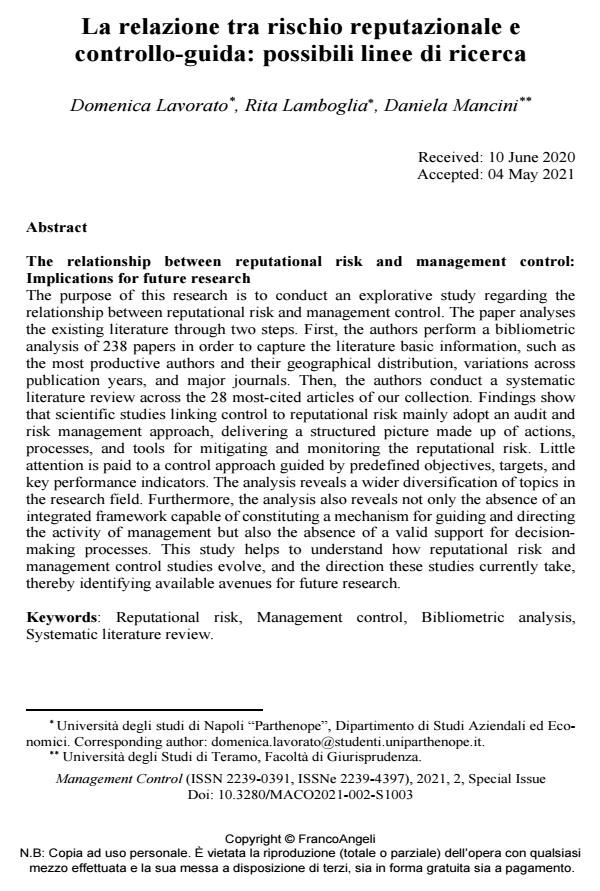The relationship between reputational risk and management control: Implications for future research
Journal title MANAGEMENT CONTROL
Author/s Domenica Lavorato, Rita Lamboglia, Daniela Mancini
Publishing Year 2021 Issue 2021/suppl. 2
Language Italian Pages 26 P. 39-64 File size 356 KB
DOI 10.3280/MACO2021-002-S1003
DOI is like a bar code for intellectual property: to have more infomation
click here
Below, you can see the article first page
If you want to buy this article in PDF format, you can do it, following the instructions to buy download credits

FrancoAngeli is member of Publishers International Linking Association, Inc (PILA), a not-for-profit association which run the CrossRef service enabling links to and from online scholarly content.
The purpose of this research is to conduct an explorative study regarding the relationship between reputational risk and management control. The paper analyses the existing literature through two steps. First, the authors perform a bibliometric analysis of 238 papers in order to capture the literature basic information, such as the most productive authors and their geographical distribution, variations across publication years, and major journals. Then, the authors conduct a systematic literature review across the 28 most-cited articles of our collection. Findings show that scientific studies linking control to reputational risk mainly adopt an audit and risk management approach, delivering a structured picture made up of actions, processes, and tools for mitigating and monitoring the reputational risk. Little attention is paid to a control approach guided by predefined objectives, targets, and key performance indicators. The analysis reveals a wider diversification of topics in the research field. Furthermore, the analysis also reveals not only the absence of an integrated framework capable of constituting a mechanism for guiding and directing the activity of management but also the absence of a valid support for decision-making processes. This study helps to understand how reputational risk and management control studies evolve, and the direction these studies currently take, thereby identifying available avenues for future research.
Keywords: Reputational risk, Management control, Bibliometric analysis, Systematic literature review.
- Corporate Reputation as Strategic Intangible Asset Diletta Vito, pp.41 (ISBN:978-3-031-93330-1)
- Management Control System in Smart and Sustainable Firms Domenica Lavorato, pp.59 (ISBN:978-3-031-81435-8)
Domenica Lavorato, Rita Lamboglia, Daniela Mancini, La relazione tra rischio reputazionale e controllo-guida: possibili linee di ricerca in "MANAGEMENT CONTROL" suppl. 2/2021, pp 39-64, DOI: 10.3280/MACO2021-002-S1003